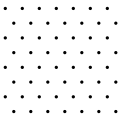Talk:Quasi-isometry
Appearance
| This article is rated Start-class on Wikipedia's content assessment scale. It is of interest to the following WikiProjects: | |||||||||||
| |||||||||||
Displayed lattice not actually quasi-isometric to the plane
[edit]The article contains this captioned image:
-
This lattice is quasi-isometric to the plane
However, the lattice in the image is bounded, and thus cannot be quasi-isometric to the plane, which is unbounded.
- If it were bounded, it would not be a lattice. The more reasonable reading is that it is intended to be only a small part of a lattice, enough for the reader to understand what the rest looks like. We cannot actually draw all of an infinite lattice with a finite number of pixels. —David Eppstein (talk) 03:49, 31 March 2017 (UTC)
Why is there an additive constant B in the definition?
[edit]I wonder if an example could be added to the article to show the necessity of including the additive constant B in the definition of quasi-isometry. 2601:200:C000:1A0:21A7:B740:95E6:BA8D (talk) 18:11, 5 September 2021 (UTC)
- The additive constant is here to allow quasi-isometries that are not necessarily continous, for example the map defined by the integer part from the reals to the integers is a quasi-isometry. I think more involved examples would be a bit cumbersome to define dproperly but the Švarc–Milnor lemma should probably be mentioned there. If nobody has a better idea I'll edit the article to add something like this. jraimbau (talk) 10:25, 6 September 2021 (UTC)


